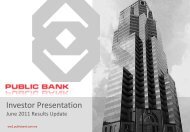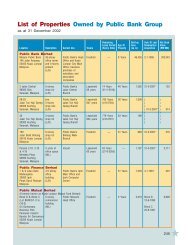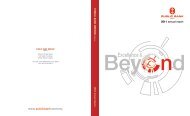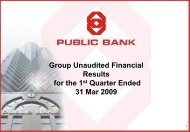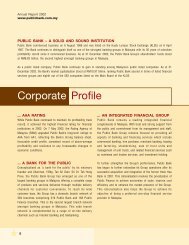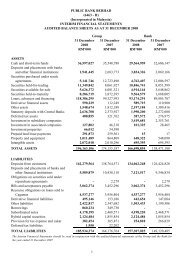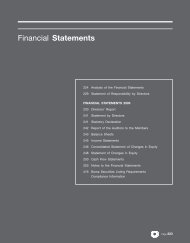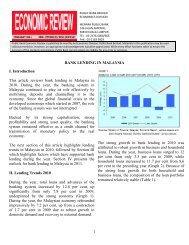Create successful ePaper yourself
Turn your PDF publications into a flip-book with our unique Google optimized e-Paper software.
166PUBLIC BANK BERHAD Annual Report 2012Resilient AlwaysChairman’s Review – OverviewCapital ManagementThe Group and the <strong>Bank</strong>’s capital adequacy ratios after deducting second interim dividends remained healthy at 14.1% and13.8% respectively as at the end of 2012, and were well above the regulatory minimum capital requirements.Regulatory EnvironmentThe <strong>Public</strong> <strong>Bank</strong> Group’s regulatory capital is governed by <strong>Bank</strong> Negara Malaysia’s (“BNM”) Capital Adequacy Frameworkguidelines. On 28 November 2012, BNM issued its finalised Basel III capital adequacy guidelines, with a phasedimplementation timeline <strong>com</strong>mencing 1 January 2013, and full phase-in by 1 January 2019. These Basel III capital adequacyguidelines are designed to strengthen capital standards and the resilience of the banking system.Under BNM’s Basel III capital adequacy guidelines, the minimum capital adequacy ratios are progressively increased from1 January 2013 to 1 January 2019, and are inclusive of the phased introduction of a new capital conservation buffer of2.5%. Additional capital requirements, including a new counter-cyclical buffer ranging from 0% to 2.5%, will be detailed outby BNM at a later stage.In its Basel III capital adequacy guidelines, BNM has introduced additional capital deductions from Common Equity Tier 1capital whereby new items such as intangible assets and investments in banking and insurance subsidiaries and associatesare now deductible from Common Equity Tier 1 capital. Tighter requirements pertaining to write-off and/or conversion toequity have also been introduced for Tier 1 and Tier 2 capital instruments. In addition, existing Tier 1 and Tier 2 capitalinstruments which do not contain these stringent write-off or conversion features will be gradually phased-out from inclusionin regulatory capital, <strong>com</strong>mencing from 1 January 2013.The <strong>Public</strong> <strong>Bank</strong> Group has incorporated these Basel III capital adequacy requirements in its capital plan as well as in settingits internal capital targets, with a view to meeting the higher minimum capital adequacy requirements ahead of BNM’simplementation deadline. As at the end of 2012, the Group is well-placed to achieve this objective, with its capital at thefollowing levels:Capital Position based on Basel III Requirements<strong>Public</strong> <strong>Bank</strong>Group<strong>Public</strong><strong>Bank</strong>MinimumBasel IIIrequirements *Common Equity Tier 1 ratio 8.5% 7.5% # 7.0%Tier 1 capital ratio 10.6% 10.0% # 8.5%Total capital ratio 14.0% 13.7% 10.5%* Minimum capital requirements inclusive of the capital conservation buffer of 2.5%, which is fully effective on 1 January 2019, ie. at the end of the phase-inperiod. These minimum capital requirements exclude the counter-cyclical buffer and any other buffers yet to be introduced by BNM.#Assuming full deduction of investment in banking and insurance subsidiaries and associates from Common Equity Tier 1 capital. However, BNM’s guidelinesallow a transitional phase-in of such deduction at 20% per annum <strong>com</strong>mencing 1 January 2014.On a forward-looking basis, the Group is well-positioned to sustain its capital ratios above BNM’s minimum requirementsas a result of its strong earnings-generation capacity and superior asset quality, coupled with its proactive capitalmanagement initiatives.




